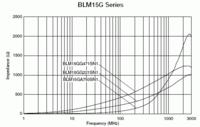mw_rookie
Member level 2

- Joined
- Mar 13, 2009
- Messages
- 48
- Helped
- 0
- Reputation
- 0
- Reaction score
- 0
- Trophy points
- 1,286
- Activity points
- 1,668
Hello,
Looking at the ferrite beads that I could find, a few questions:
1. Are ferrite beads used a chokes at high freq. like 4 GHz and above i.e. are they available at all at that frequency?
2. If not, then when chip inductors are used as RF chokes at higher freq., most manufacturers do not provide the impedance ( R and XL) characteristics for chip inductors. All you know is the SRF. Then, how do we pick the right chip inductor?
3. Also, is it then preferred to have a resistor in series with the chip inductor to emulate(for the lack of a better word) a ferrite bead RF choke?
I'd appreciate any thoughts on the same.
Thanks.
Looking at the ferrite beads that I could find, a few questions:
1. Are ferrite beads used a chokes at high freq. like 4 GHz and above i.e. are they available at all at that frequency?
2. If not, then when chip inductors are used as RF chokes at higher freq., most manufacturers do not provide the impedance ( R and XL) characteristics for chip inductors. All you know is the SRF. Then, how do we pick the right chip inductor?
3. Also, is it then preferred to have a resistor in series with the chip inductor to emulate(for the lack of a better word) a ferrite bead RF choke?
I'd appreciate any thoughts on the same.
Thanks.



